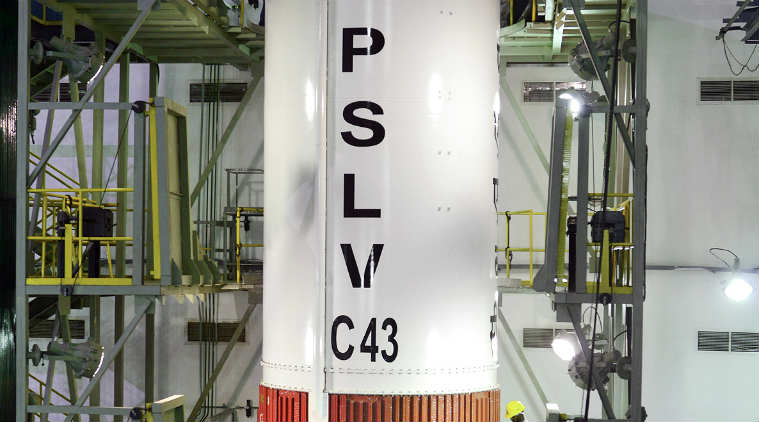 ISRO PSLV-C43 launch, HysIS satellite projection, PSLV mission highlights: This mission completes the 45th flight conducted by a polar satllite launch vehicle (PSLV) rocket by the Indian spacey agency. (Image Source: ISRO)
ISRO PSLV-C43 launch, HysIS satellite projection, PSLV mission highlights: This mission completes the 45th flight conducted by a polar satllite launch vehicle (PSLV) rocket by the Indian spacey agency. (Image Source: ISRO)
ISRO PSLV-C43 mission timings, launch payload, orbit projection highlights: The Indian Space Research Organisation (ISRO) has launched the PSLV-C43 with a payload of 31 satellites. This launch took place from the first launch pad of the Satish Dhawan Space Centre in Sriharikota. Marking the 45th mission that uses the polar satellite launch vehicle (PSLV) rocket, ISRO has launched its latest Earth-mapping satellite, HysIS, as part of the mission.
The HysIS satellite adds a mass of 360kg to the payload, and has been launched besides 30 other satellites from six nations. Out of these, 23 are from the United States. These smaller satellites have added a weight of 281.4kg to the payload, and adds to ISRO’s list of 239 foreign satellites that have already been launched. While ISRO is only using the lightest version of the PSLV rocket, the core-alone PSLV, it is expected to be modified for future missions as the Indian space agency plans manned missions.




ISRO has now confirmed that all 31 satellites carried by PSLV-C43 have been successfully launched. While the HysIS satellite projection was confirmed almost two hours back, the probe had to complete the second stage, that involved the foreign satellites. Of those, many will either by Earth-observing bodies or communications satellites. One, though, is also expected to carry out scientific studies of the atmosphere. The confirmation fro ISRO can be seen here.
The ISRO live blog has notified us of the completion of propellant filling on the PSLV-C43 rocket. This will enable the probe to stabilise around a height of 504.5km, at which point the 30 satellites will be projected. The PS-IV corrections are in progress, as the launcher will reorient into its projection position.
The PSLV-C43 mission is not over, as the rocket still holds a payload of 261.5 kg, that is made up by 30 foreign satellites, including 23 from the United States. While their objectives vary from communication and Internet of Things (IoT), to scientific research of the atmosphere and space-based experiments. These will be projected off a height of 502.5km, after the rocket completes two successful PS-IV restarts.
HysIS, or the hyper spectral imaging satellite, will be used for detailed analysis of weather patterns, which is expected to aid agriculture. Also, it will help monitor India's coastlines, to estimate conditions for fishing in the high seas, and possible security matters. Above all, it will provide insights into the Earth's geology, with the possibility of analysing seismic activity as well. The mission will last until 2023, as the satellite will maintain a constant position with respect to the Sun through its lifetime.
The mission's main payload, the hyper spectral imaging satellite (HysIS), has been successfully separated from the rocket, and has been launched into its polar Sun synchronous orbit. This was achieved at a height of 636.6km, with an inclination angle of 97.67 degrees. ISRO director K Sivan and mission director Hutton can be seen sharing handshakes with other members of the launch observation team. The official confirmation of the same can be seen here.
Through the ISRO live stream, the metrics at time of writing show an altitude of over 640km from the Earth's surface. In the process, it has completed its first three stages without failure. The 30 partnering satellites will be projected from PSLV-C39 in another 90 minutes, as HysIS has been successfully separated from the rocket.
The PSLV-C43 embarks on its flight with the 31-satellite payload onto the slightly overcast skies of Sriharikota. ISRO confirms a successful launch, but one would have to see the stages of the rocket to be sure that HysIS and its accompanying satellites have made their way unharmed. The rocket will be tracked up to a height of 700km, as PSLV-C43 will set the earth-mapping probe on a polar solar synchronous orbit at 636km above the Earth's surface.
Mission director Hutton counts down the achievements of the PSLV missions as the countdown closes to within five minutes of launch. With the HysIS satellite, India will be able to estimate greater geological studies, as well as weather analysis, coastal studies and agricultural mapping of the Earth's surface.
The mission director of the PSLV-C43 rocket, R Hutton, has just confirmed that all operations and manoeuvres leading to the launch have been successfully put in place, and has given his consent for the launch to carry on as planned. Given the status of the mission, the PSLV launch sequence will begin from 9:57:30, which is 30 seconds before the rocket's final launch.
The key part of the PSLV-C43 mission is the HysIS satellite, that will further India's earth-mapping abilities. Designed around the ISRO Mini Satellite-2 (IMS-2) bus, the satellite has a weight of 360kg, that can be easily handled by the core-only PSLV model. This will make observations within the electromagnetic spectrum, among the visible, near infrared and far infrared bandwidths. Its studies will create improvements in agriculture, coastal surveillance, weather monitoring and more.
ISRO has confirmed in its live updates for the mission that PSLV-C43 will be launched at 9.58am, instead of the 9.30am timing that had been decided earlier. While the delay is not expected to make any changes to the launch, it can be considered a safeguard from India's space agency, that aims to independently send men into space in the coming years. The countdown for PSLV-C43 has been marked from 5:48am this morning.